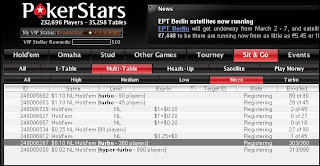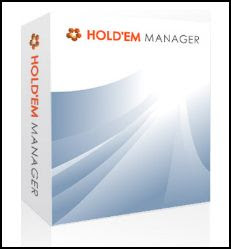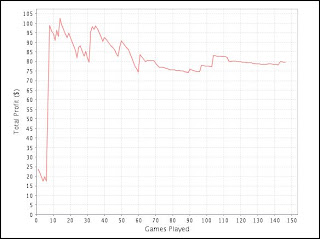 Since my challenge on Stars incorporates building from .10 cent micro-limit Turbo Tournaments, a definite comparison between the types of play in Turbo vs. Non-Turbo is in Order. There are not a lot of strategy articles for Turbos. So, for our comparison study, we will be looking at NORMAL stack tourneys, which means both a normal speed and a Turbo speed will start with the same stacks (1500 in chips). While the blinds and minutes per entry level are different for Full Tilt than PokerStars, we will work with Stars as the focus for our study. There are many micro limit, multi table sngs running constantly on PokerStars. Some blind structures are a little different than others. However, the main difference between Normal Speed and Turbo, is the increase in levels (10 mins for a Normal speed, 5 mins for a Turbo speed). PokerStars also starts out the first blind lower than Full Tilt, at 20 vs. 30 for the latter.
Since my challenge on Stars incorporates building from .10 cent micro-limit Turbo Tournaments, a definite comparison between the types of play in Turbo vs. Non-Turbo is in Order. There are not a lot of strategy articles for Turbos. So, for our comparison study, we will be looking at NORMAL stack tourneys, which means both a normal speed and a Turbo speed will start with the same stacks (1500 in chips). While the blinds and minutes per entry level are different for Full Tilt than PokerStars, we will work with Stars as the focus for our study. There are many micro limit, multi table sngs running constantly on PokerStars. Some blind structures are a little different than others. However, the main difference between Normal Speed and Turbo, is the increase in levels (10 mins for a Normal speed, 5 mins for a Turbo speed). PokerStars also starts out the first blind lower than Full Tilt, at 20 vs. 30 for the latter.Turbos are designed to be fast, fast paced action, fast paced structure (kinda like Rush Poker, only a little slower). You need to be comfortable with Coin-flip hands (the kind you want to avoid in normal tournaments and Sit N Gos). This is kinda like gambling, but is comparative more to BlackJack than a slot machine (since there is SOME skill involved). At some point in time during the Turbo, you will be short stacked.
You can click on the images below to enlarge.

When the blinds escalate to 1k and 2k, I've rarely seen anyone with 100 times the Big Blind - especially in MTT turbo SNGs, with a fixed number of players. To be successful in this environment, you need to set yourself up so that you win the race at showdown. Experience will tell you when you need to push for the coin-flip, the race. Some folks needlessly gamble (such as going all in the first hand with J9o and three other callers). Some folks don't shove when they should - waiting for the AA, KK, AKs hand. My stats say that I get those hands 2.7% of time out of 19 tournaments. And with multi-tablers, slow connections, and people running the clock down to get further ahead without playing a hand, you can easily get to 150 blinds and see only 16 hands. So the traditional wait for top cards, as in normal speed tourneys, won't get you very far in Turbos.
Turbos are excellent training tournaments. They are all about playing your first two cards, basically a pre-flop game. Therefore, you learn good starting hand values. If you have an analysis tool like Holdem Manager or Poker Tracker, you can get even more insight into how your starting hand and hole cards are working for you. For example, one strategy site recommends limping from amy position with Axs or Kxs. After having analyzed my play, I can see that won't work in Turbo Tourneys. They are DEFINITELY NOT shoving hands in the early rounds. The only value I can possibly see in these now - is from late position with a decent stack size, and only Axs.
Turbos also offer the opportunity for profit with short time investment. The 360 man .10 cent Turbo on Stars takes about 2 hours or so. The same Daily Dollar on Full Tilt will take several hours. Some deep stack big buy in events can last 8 or more hours (well, they want you to get your money's worth). Played correctly, the .10 cent turbo tourney will work well as the launching pad for higher buy in tourneys later on, as the Bankroll Building Challenge continues.
Now a quick comparison between the Turbo and Normal Tourney on Stars, even though the stacks start at 1500 in both, due to 5 minute blind levels, you will become short stacked much more quickly. After 30 minutes in a Turbo Tourney, the blinds are 150, and 10% of your starting stack. In a Normal Speed $1.20 sit n go, after 30 minutes, the blinds are at 50, which means your starting stack was 30 times the blind.
Now, my experience has shown that at the lower buy in level, folks are ready to gamble the pre-flop game right away (that is, toss all you chips into play with what YOU think will win the pot - or playing your coin flip, race hands). Patience is very important. In the early levels, while you have from 20 to 40 times the big blind in your stack, just play solid poker. And try to stay out of the mash which is folks shoving with any two cards. When folks are making mistakes, in order to try and build a stack, you can capitalize on the mistakes, and build your own (here is where direct observation, vs HUDS, comes in handy). But good solid poker is needed for this situation. Your stack of 1500 chips will go further if you don't try to steal the blinds and small bets worth 100 total, and will probably get called anyway.

An excellent example: you have AKs under the gun. You raise, and get called in later position. The flop shows no A nor K. You make a standard Cbet, and the late position player raises. Most folks think, its early in the tournament, need to shove NOW. However, your opponent has QQ, and down you go. In fact, going all in with this hand, would probably have yielded the same results, again busting you out. Now, the preferred solution? Less bluffing and stealing in the early phase. No K or A on flop, then probably better to check than use a continuation bet. Save those chips. Blinds at 50 and below, is not the time to try and steal. If you miss the flop, you miss it. In a normal speed tournament, go ahead and make the Continuation bet, because you have a LOT LONGER to raise and play big hands again. Turbos don't offer that type of time luxury. The time to shove with AK UTG+, is after you are short stacked, not before.
Difference for early stages of Turbos, less action on the button, less raising to steal. If you do attempt the steal, you will more than likely need to make a continuation bet, and anyone with a decent draw is going to give you action. Turn down the steal and bluff machines, now is not the time. Don't defend with your weak hands. If you didn't make the flop, or you are not getting EXTREMELY good pot odds to call (you will need to let go of the implied odds here) your draw, it is best to fold. Your A high will probably not hold up.
An example for play in the early stages, say blinds are 50, someone 3 bets UTG, then from late position can call with smaller pockets. The reason being, if you hit your set, then you'll probably be paid off. Maybe UTG has AA, and you made a set of 99s on the flop. UTG continues with bet, and is probably pot committed. You raise, and more than likely, since this is a turbo tourney, even pocket 10s will call your raise, and pay you off.
Play changes when the blinds are 100 to 200, no antes yet. You are short stacked, 1200 chips (haven't played a pot), and the blinds are 150, Stealing just to steal is not profitable at this stage, whether short stacked or Medium Stacked. The short guys are going to go all in. If you are short stacked, and manage to steal the blinds, you are only picking up 225 chips, making your 1200 into 1425. You are still short stacked. Mid stacked, even if the blinds are short stacked, either pick up 225 more, or end up in race for 1300 more chips. If lose, then have risked almost 1/3 of chip stack JUST to steal 225 chips. Not a good play. There will be a lot of races during the turbo. Unless you have a really good hand on the button, this race is not profitable.
When the antes kick in, play changes again. For the .10 cent turbo, the antes kick in at 125/250 blinds, 25 antes. The pot is now 600 or thereabouts in the middle. You bet 500 or more, in hopes of picking up 600. If you have fairly decent cards in late position, then go for the steal. If the short stack big blind goes all in, then call. You want to have cards that race 60 to 40 (you being the underdog or better). Its okay for the race, if You have the chip stack (7500 or better looks good here). If calling the all in is only 700 more chips, this is the place to race. Marginally good starting hands will qualify. If you lose, still in good position. However, the short stack has waited around for a good starting hand, finally got one, and 40% of the time will lose.
Now, this strategy significantly differs from the typical Normal Speed Tourney. (Play tight in the early stages, play regular poker in the middle stages). Making these same decisions over a large number of turbo tournaments, you will come out ahead. You will win races, even as the 40% underdog, and you will be able to steal blinds. You will accumulate a lot of chips, and get in position to win. Over the long haul, you will be successful. That's why Bankroll Management is so important. You need to not be afraid to lose, but over the long haul, you will end up winning with the right mathematical decisions.
As to the quality of Marginal Hands? I took some leeway here at the lower end of the Hutchinson Point System. Lower pocket pairs down to 77, even 66. Axs and Kxs. Qxs down to Q6. Suited connectors with gaps down to 10-8, and non-suited connectors down to 98o. That's just a guesstimate, can tweak later.
Nearing the Bubble, you will find a LOT of slow play, since the blinds are probably over 1k. You can choose to continue the aggressive approach, or, if you have between 35 and 50 times the big blind, you can switch back to tight play, and wait until folks start to go a little crazy with the chip stacks after the bubble bursts.

The final table of turbo different than regular tournament. As mentioned before, many short stacks here, and more often than not, no one has a clearly defined chip lead. And, once reach the final table, the dynamics of play change again. Obviously, the short stacks are gonna fold, waiting for someone to bust someone else out, moving them up in the money. I've also seen short stacks actually rebuild, as the races change in their favor. If you are well stacked, and have been playing aggressively, then you will need to tighten up, since everyone has seen you play, or they've watched from another table. Only go with the Good Hands as in the start of the tournament, opponents expect you to try and take advantage, and they will try to take advantage of you. If you are short stacked, and can make a few rounds (maybe 6 hands or a few more), be patient and wait to get a good hand. If someone bust out prior to your good hand, you move up. No matter what you shove with, you are probably going to get called.
































